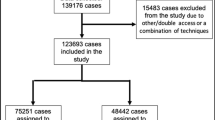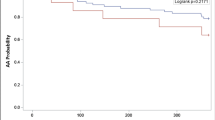Abstract
Introduction
The data about the incidence of subclavian venous (SCV) obstruction or thrombosis after biventricular device implantation is limited. Therefore, we aimed to assess the incidence and predictors of venous obstruction after biventricular device implantation with or without a defibrillator in patients with left ventricular systolic dysfunction and cardiac dyssynchrony.
Method and results
Eighty-six patients who had undergone biventricular device implantation were included in the study. Subclavian vein was patent in 61% of all participants. Among the patients with subclavian obstruction (n = 33), 8 had mild obstruction, 15 had severe obstruction, and 10 had total occlusion. The presence of additional implantable cardioverter defibrillator (ICD) and the number of leads that were used were found to be significant covariates of obstruction in subclavian vein after biventricular device implantation (p = 0.004 and p = 0.01, respectively). Atrial fibrillation after biventricular pacemaker and ICD implantation was significantly related with total occlusion (r = 0.3, p = 0.005 and r = 0.24, p = 0.003, respectively).
Conclusion
Patients who are candidates for biventricular device implantation are at increased risk for venous obstruction when compared with other pacemaker patients and this causes higher incidence of venous obstruction among these patients.
Similar content being viewed by others
Explore related subjects
Discover the latest articles and news from researchers in related subjects, suggested using machine learning.References
Young, J. B., Abraham, W. T., Smith, A. L., Leon, A. R., Lieberman, R., Wilkoff, B., et al. (2003). Combined cardiac resynchronization and implantable cardioversion defibrillation in advanced chronic heart failure: the MIRACLE ICD Trial. Multicenter InSync ICD Randomized Clinical Evaluation (MIRACLE ICD) Trial Investigators. JAMA, 289(20), 2685–2694.
Bristow, M. R., Saxon, L. A., Boehmer, J., Krueger, S., Kass, D. A., De Marco, T., et al. (2004). Cardiac-resynchronization therapy with or without an implantable defibrillator in advanced chronic heart failure. Comparison of Medical Therapy, Pacing, and Defibrillation in Heart Failure (COMPANION) Investigators. The New England Journal of Medicine, 350(21), 2140–2150.
Martinez-Sellés, M., Bueno, H., Almendral, J., & Diaz-Castro, O. (2001). Pulmonary embolism after pacemaker implantation. Texas Heart Institute Journal, 28(4), 318–319.
Rozmus, G., Daubert, J. P., Huang, D. T., Rosero, S., Hall, B., & Francis, C. (2005). Venous thrombosis and stenosis after implantation of pacemakers and defibrillators. Journal of Interventional Cardiac Electrophysiology, 13(1), 9–19.
Haghjoo, M., Nikoo, M. H., Fazelifar, A. F., Alizadeh, A., Emkanjoo, Z., & Sadr-Ameli, M. A. (2007). Predictors of venous obstruction following pacemaker or implantable cardioverter-defibrillator implantation: a contrast venographic study on 100 patients admitted for generator change, lead revision, or device upgrade. Europace, 9(5), 328–332.
Van Rooden, C. J., Molhoek, S. G., Rosendaal, F. R., Schalij, M. J., Meinders, A. E., & Huisman, M. V. (2004). Incidence and risk factors of early venous thrombosis associated with permanent pacemaker leads. Journal of Cardiovascular Electrophysiology, 15(11), 1258–1262.
Pauletti, M., Di Ricco, G., Solfanelli, S., Marini, C., Contini, C., & Giuntini, C. (1981). Venous obstruction in permanent pacemaker patients: an isotopic study. Pacing and Clinical Electrophysiology, 4(1), 36–42.
Korkeila, P., Nyman, K., Ylitalo, A., Koistinen, J., Karjalainen, P., Lund, J., et al. (2007). Venous obstruction after pacemaker implantation. Pacing and Clinical Electrophysiology, 30(2), 199–206.
Lickfett, L., Bitzen, A., Arepally, A., Nasir, K., Wolpert, C., Jeong, K. M., et al. (2004). Incidence of venous obstruction following insertion of an implantable cardioverter defibrillator. A study of systematic contrast venography on patients presenting for their first elective ICD generator replacement. Europace, 6(1), 25–31.
Bracke, F., Meijer, A., & Van Gelder, B. (2002). Extraction of pacemaker and implantable cardioverter defibrillator leads: patient and lead characteristics in relation to the requirement of extraction tools. Pacing and Clinical Electrophysiology, 25(7), 1037–1040.
Goto, Y., Abe, T., Sekine, S., & Sakurada, T. (1998). Long-term thrombosis after transvenous permanent pacemaker implantation. Pacing and Clinical Electrophysiology, 21(6), 1192–1195.
Author information
Authors and Affiliations
Corresponding author
Rights and permissions
About this article
Cite this article
Bulur, S., Vural, A., Yazıcı, M. et al. Incidence and predictors of subclavian vein obstruction following biventricular device implantation. J Interv Card Electrophysiol 29, 199–202 (2010). https://doi.org/10.1007/s10840-010-9516-2
Received:
Accepted:
Published:
Issue Date:
DOI: https://doi.org/10.1007/s10840-010-9516-2




